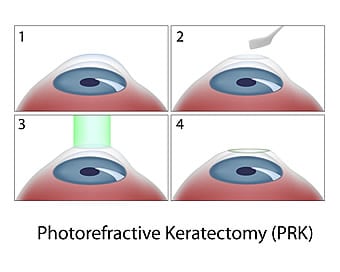Posted by: Clear Advantage in Featured, LASIK on March 16, 2023
LASIK is not your only option to correct your vision permanently. Different types of corrective eye procedures are available, and a popular one you may not be aware of is called PRK.
When making a decision as big as the one to get a vision correction procedure, you should be aware of all your options. Having so many of these procedures available at Clear Advantage Vision Correction Center allows us to choose the one that is the best fit for you.
While LASIK and PRK produce virtually identical results, these procedures have some key differences. Keep reading to find out how LASIK and PRK are different!
How Do LASIK and PRK Work?
LASIK stands for “laser-assisted in-situ keratomileusis.” The procedure gently reshapes your cornea, the transparent front surface of the eye.
When your cornea is an irregular shape, it prevents light from focusing onto the retina at the back of the eye. This causes blurry vision, and why people have refractive errors like nearsightedness, farsightedness, and astigmatism.
During the procedure, the surgeon creates a small flap in the top layer of the cornea. They fold this back to access the inner tissue of the cornea, where they will reshape the tissue.
Once this is complete, the flap is folded back into place. It begins healing immediately.

PRK stands for “photorefractive keratectomy.” This procedure also works by reshaping the cornea.
However, in this case, no flap is created in the cornea. Instead, the epithelium is removed.
The surgeon can then go in and reshape the inner corneal tissue. The epithelium grows back on its own, with its cells naturally regenerating.
With both procedures, numbing drops are placed in the eye, so patients experience minimal discomfort. You may feel some light pressure.
You will also be asked to focus on a light so that your eyes remain stationary during the surgery. LASIK and PRK are relatively quick, with each eye taking about ten minutes or less.
What is Recovery Like for LASIK and PRK?

Whether you get LASIK or PRK, we encourage our patients to take it easy the rest of the day following their procedure. You will receive eye drops to moisturize your eyes and protect them from infection.
You will also be given goggles to wear when you sleep and sunglasses for when you go outside. With PRK, you’ll have a contact lens placed over the eye.
It acts as a bandage. A bandage placed over the eye is necessary to protect the epithelium as it grows back. This is typically left on for four to six days.
Because it does not remove the epithelium, LASIK has a faster recovery period than PRK. Most patients can resume most normal activities within a day or two.
PRK takes a little longer, with patients feeling mostly back to normal in a week or less. Full recovery usually takes at least a month.
After surgery, some mild discomfort is normal. You may experience temporary light sensitivity, watery eyes, and a slight burning sensation. You can expect these symptoms to dissipate as your eyes heal.
How Do LASIK’s Results Compare to PRK’s?

Both LASIK and PRK can provide life-changing results. If you want to leave your glasses or contacts behind, either procedure can make that possible. Their results are virtually identical.
Regarding the outcome of their procedure, most LASIK and PRK patients are more than satisfied with their results. With LASIK, 99% of patients achieve 20/20 vision or better. PRK also has a very high success rate of 95%.
Both procedures are designed to permanently correct refractive errors. As a result, glasses or contacts are no longer necessary for most patients. They no longer need to rely on visual aids daily to see clearly!
Who is a Good Candidate for LASIK and PRK?
Both LASIK and PRK can treat nearsightedness, farsightedness, and astigmatism. Patients must be 18 years or older to undergo either procedure. Their prescription should also have remained stable for the last year, and they should have generally healthy eyes.
There are a few reasons why a patient would opt for PRK over LASIK. Some people do not qualify for LASIK due to having thin corneas.
When your corneas are too thin, creating a flap in the cornea becomes unsafe. The same applies to when your corneas are unusually curved. PRK can allow you to achieve your vision goals still.

In addition, PRK is often better for patients with dry eyes. If you have a history of dry eye, you may experience fewer symptoms with PRK compared to LASIK. This is because, with PRK, less corneal irritation can trigger dryness.
If you are an athlete or have a very active lifestyle, your surgeon may recommend PRK instead. When you get LASIK, the flap can become dislodged. With PRK, you won’t have to worry about disrupting the healing of the delicate flap and potentially cause complications.
Are you considering a vision correction procedure like LASIK or PRK? We are here to help you decide which procedure is right for you.
Schedule an appointment at Clear Advantage Vision Correction in Portsmouth, NH, today! Isn’t it time to see the world with crystal-clear precision?






